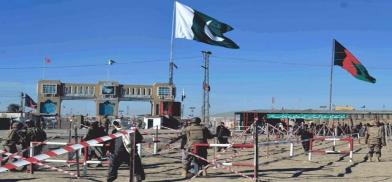Tensions in Pak-Afghan relations: Lessons in it for India?
Afghanistan is important to India’s continental economic aspirations, including closer ties with Central Asia and Iran. These goals are currently hampered by Pakistan’s blockade of Indian access to the region.

Escalating tension between Afghanistan and Pakistan has once again generated geopolitical tremors in the region. While global media and analysts have started focussing on recent incidents like the closure of the Chaman border crossing for a week following a shooting incident leading to the death and injury of Pakistani servicemen, a terror attack on the Pakistan embassy in Kabul, allegedly carried out by the ISIS, the spiralling spat between the Taliban and Pakistan government officials, and Taliban’s unwillingness or incapability to crack down on Tehreek-e-Taliban Pakistan (TTP), has led to some analysts describing it as a “volatile case of a souring patron–client relationship.”
Despite initial triumphalism in Pakistan's highest echelons after the August 2021 Taliban takeover, the uncomfortable truth was closer to an amateur video shot taken on a mobile phone and widely circulated on WhatsApp that showed Taliban militia men mocking Pakistani border security men by pointing guns at them and saying “You, next.” There was, like during the 1990s, considerable infighting amongst different factions within Afghanistan’s ruling regime, putting an enormous strain on its relations with Pakistan.
Since coming into power, the Taliban has defied Pakistan, its main state benefactor during the insurgency against the United States military and the deposed Afghan government. It has done so by challenging the status of the Afghan-Pakistan border and providing a haven to the anti-Pakistan insurgent group the Tehreek-e-Taliban Pakistan (TTP), also known as the Pakistani Taliban, which has killed thousands of Pakistanis and seeks to establish a Taliban-style, Shariah-compliant state in Pakistan.
Relations have deteriorated to the point that frequent border skirmishes between the Pakistani border security forces and various Afghan infiltrating groups are being reported frequently. Recently Pakistan has also conducted air strikes across the border in Afghan territory targeting some rebel strongholds, leading to protests by the Taliban regime.
India's Afghanistan policy
India is thus required to proceed very cautiously in these turbulent times. New Delhi’s initial response to the Taliban takeover came in the form of the closure of its embassy in Kabul and its missions in major Afghan cities. Informal channels of communication, however, were maintained between New Delhi and Kabul, with the Taliban requesting India to keep its embassy open and continue its scheduled commercial flights to Kabul, and India urging the Taliban leadership not to allow Afghanistan to be a base for anti-India activities. Though India is unlikely to officially recognize the Taliban government anytime soon, its substantial economic commitments and investments in Afghanistan, roughly to the tune of $3 billion, as well as the presence of a sizeable number of Afghan students and families in India, make the maintenance of a sort of working relations and communications absolutely vital.
Analyst Manoj Joshi, of the Observer Research Foundation, thinks that Delhi does not see the Taliban itself as a threat to India, but its ties with Pakistan and jihadi groups such as Lashkar-e-Tayyiba and Jaish-e-Mohammad are worrisome. Afghanistan is important to India’s continental economic aspirations, including closer ties with Central Asia and Iran. These goals are currently hampered by Pakistan’s blockade of Indian access to the region.
One persistent criticism concerning India’s Afghanistan policy has been its approach to making bilateral relations essentially government oriented. While it is normal for international relations to be conducted through respective governments, given Afghanistan’s complex history and the limited legitimacy of the Kabul-based government (especially the America-backed one which had come to power following the fall of the Taliban), it would perhaps have been more prudent for New Delhi to engage itself with other political actors and pressure groups in Afghanistan. As analysts Rudra Chaudhuri and Shreyas Shende argue, the strategy of the Indian government to only work through the Kabul regime proved to be unrealistic, as Afghanistan’s security situation deteriorated in the late 2010s. While India did open informal dialogue channels with the Taliban in the early 2010s, by the time of the February 2020 agreement these channels had become inactive. Another analyst, Abhijit Iyer-Mitra, reporting on the basis of his field trips undertaken inside the country during 2019, had also noted how India had blundered by not engaging with contending sections within the Taliban and other anti-Kabul groups. The Taliban, according to Iyer-Mitra, is not a solid cohesive group with rigid ideological moorings but easily blends into the local population.
This criticism of India’s diplomatic failure to reach out to non-Kabul groups in Afghanistan, however, cannot be overstretched beyond a point. Many analysts, particularly based in the West, are silent on the abysmal failure of the American establishment’s strategic assessment of the Taliban’s ability to capture power in Afghanistan so quickly and completely. The American and the West’s withdrawal almost represented a strategic collapse, to be preserved in imagery forever by the pictures and videos of the desperate scramble out of Kabul airport with teeming crowd pleading and desperately clinging to the wheels of departing aircraft. Years of engagement with the Taliban groups based in Doha, Qatar and in other locations, in secret and also openly, did not really help them in framing a successful policy vis a vis the Taliban or in restoring peace and stability within Afghanistan.
Umbilical links with Pakistan
South Asian analyst Alok Bansal, of the India Foundation, reminds us that irrespective of minor differences that keep popping up and will continue to do so between Pakistan and Afghanistan, the fact is that both Islamabad and Rawalpindi have invested heavily in the Taliban and this relationship is decades old. No efforts will be able to dent it in the foreseeable future. Taliban may at the moment want to project to both their domestic audience, as well as the international community their distance from Islamabad, but their umbilical cord is attached to Rawalpindi, and it would be foolhardy to overlook this fact.
He says that the Taliban is an ideological organisation and notwithstanding the attempts by many to create a Taliban 2.0, it has shown its true colours. Having promised the moon during negotiations in Doha, it has gone back to its old ways as soon as it consolidated power and all its promises about inclusive government and women have disappeared into thin air.
Moreover, the Taliban takeover is likely to boost the already flourishing opium cultivation and drug trade in the region. The global trade in illicit Afghan opiates has become one of the world's greatest transnational drug and crime threats, with Afghan opiates being trafficked to every continent today, except South America. The US-backed Afghan government did not manage to control it in spite of several attempts, given that drug manufacturing had become a profitable cottage industry in the Afghan rural sector, driven by the lack of constructive economic opportunities.
American policy failure
In the American failure lies a paradox: Washington’s massive military juggernaut has been stopped in its steel tracks by a small pink flower – the opium poppy. Throughout its three decades in Afghanistan, Washington’s military operations have succeeded only when they fit reasonably comfortably into Central Asia’s illicit traffic in opium – and suffered when they failed to complement it.
“In one of history’s bitter ironies,” writes Alfred W McCoy, “Afghanistan’s unique ecology converged with American military technology to transform this remote, landlocked nation into the world’s first true narco-state – a country where illicit drugs dominate the economy, define political choices and determine the fate of foreign interventions.” Following its promise to eradicate the drug trade, the Taliban regime did issue a decree in April 2022 banning the production and sale of all types of illicit drugs in the country. But it proved to be ineffective in a country so dependent upon opium production and trade. According to an estimate the amount of land under poppy cultivation inside Afghanistan almost tripled between 2002 and 2020, and the country has also started mass production of cheap methamphetamine using an abundant local plant called ephedra. According to a recent UNODC (United Nations Office on Drugs and Crime) report, opium cultivation in Afghanistan has increased by 32 per cent over the previous year to 233,000 hectares – making the 2022 crop the third largest area under cultivation since monitoring began. Cultivation continues to be largely concentrated in the southwestern parts of the country, which accounted for 73 per cent of the total production.
As an immediate neighbour, India is in danger of becoming one of the chief target areas for this opiate supply. In January 2022 the Director-General of India’s Narcotics Control Bureau S.N. Pradhan admitted that the Taliban takeover of Afghanistan could lead to a rise in drug trafficking which already occurs along established smuggling routes via Punjab (sometimes using drones) or by sea to India’s west coast. India thus needs to take into account the booming drug supply while trying to engage with the new regime in power in Afghanistan.
Another major geopolitical concern for India was the Chinese connections with Afghanistan since the second Taliban takeover. The key factors which catalysed Chinese engagement with Afghanistan were mining opportunities and deeper networking and interconnections within the ambit of the Belt and Road initiative. But this initial bonhomie was soon strained by the inability of the Taliban regime to neutralise the East Turkistan Islamic Movement (ETIM) trying to create an Islamic state by carving out territories from China's Xinjiang region.
This Chinese anxiety was expressed in the official statement issued after former Chinese Foreign Minister Wang Yi’s visit to Kabul in March 2022 which mentioned China’s expectations from the Afghan government to crack down on all terrorist forces including the ETIM. Chinese disappointment with the Taliban may witness greater Chinese involvement in the region in trying to put pressure on the regime as it has been trying to do in Pakistan in order to limit its losses on the massive investment in the China-Pakistan Economic Corridor and sporadic local attacks on Chinese workers and professionals in various areas of Pakistan. This is bound to generate further complications for India’s bilateral and regional engagements.
Lessons for India
India’s concerns with developments in Afghanistan are more immediate as it is within India’s neighbourhood and remains an important South Asian player as well as a member of the South Asian Association for Regional Cooperation (SAARC). The engagement in the two decades between 2001 and 2022 has seen India further its social, cultural, diplomatic and economic relationship with Afghanistan. In light of the several thousand Afghans stranded in India, and India’s economic commitments in Afghanistan today, engagement with the Taliban needs to continue, either at the official or unofficial level. While informal dialogues have already started, more concerted conversations would still be required for both India and Afghanistan to air their respective interests and concerns regarding each other.
The lesson the Indian government could take from the last two decades - and perhaps even the 1980s - is that control over Kabul does not mean that the writ of the ruling regime runs throughout the country. India needs to engage with multiple power bases inside Afghanistan to retain its relevance in the evolving regional and local political dynamics.
(The author is a professor of history at Calcutta University. The article is part of a research project sponsored by the Bandhan-Konnanagar HP Ghosh Research Centre, Views are personal. He can be reached at chakrabartishantanu@hotmail.com)














Post a Comment